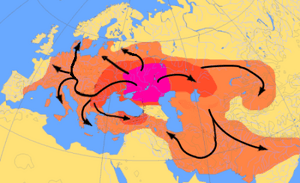Human migration facts for kids
Human migration is when people move from one place to another to live there. This often happens with many people at once. People might move within their own country or to a different country. Humans have moved around a lot throughout history, even before written records.
Sometimes, people choose to move. Other times, they are forced to leave their homes. This can happen because of wars, religious or political unfair treatment, famine (not enough food), or natural disasters like floods.
When people are forced to move, they are called refugees. Many refugees are children and women. They might live in very difficult conditions, without enough food, a safe place to live, clothes, schooling, or medical care.
Contents
Why People Move: Rural to Urban Areas
Rural-urban migration is when people move from the countryside to towns and cities. This is also called urbanization. Many things make people leave the countryside:
- Sometimes, there are too many people for the land to support.
- There can be high birth rates and not enough food.
- New machines in farming mean fewer jobs for people.
Farming can be very hard work, with long hours and low pay. Many farmers grow just enough food for their families, which is called subsistence farming. In some countries, farmers don't have enough money for modern machines. Natural disasters like droughts, hurricanes, floods, or volcanoes can destroy villages and crops. Also, there might not be many services like schools and hospitals in the countryside.
People move to cities hoping for better-paying jobs and a better life. They look for more services like schools, doctors, and fun activities. Cities also offer a more varied lifestyle with shops, restaurants, theaters, and nightlife.
When people arrive in a new city, they often have little money. This means they can't easily buy or rent a house. They might have to build a temporary shelter using cheap materials. Some people eventually give up and go back home. Children of migrant workers often face challenges getting an education.
In their new country, migrants sometimes struggle to fit in. They might be treated differently. However, their help is often needed, even if some local people don't like immigrants because they might compete for jobs. More people in cities can mean more traffic and sometimes more crime. But immigrants also help cities grow by providing workers, investing money, buying things, paying taxes, and helping businesses succeed.
Ancient Human Journeys
Ancient groups of people, like the Proto-Indo-Europeans, moved many times between 4000 and 1000 BC. Scientists believe this happened based on how languages spread.
Modern Human Journeys
People continue to move in modern times. Some choose to move within their region, country, or to another country. Other times, people are forced to move. This includes the slave trade (where people were bought and sold) and other forced movements. People who move are called migrants. Depending on the situation, they might also be called emigrants (leaving a country), immigrants (entering a country), or settlers (people who move to a new area to live).
Sadly, many people have died while trying to migrate.
Images for kids
See also
 In Spanish: Migración humana para niños
In Spanish: Migración humana para niños





